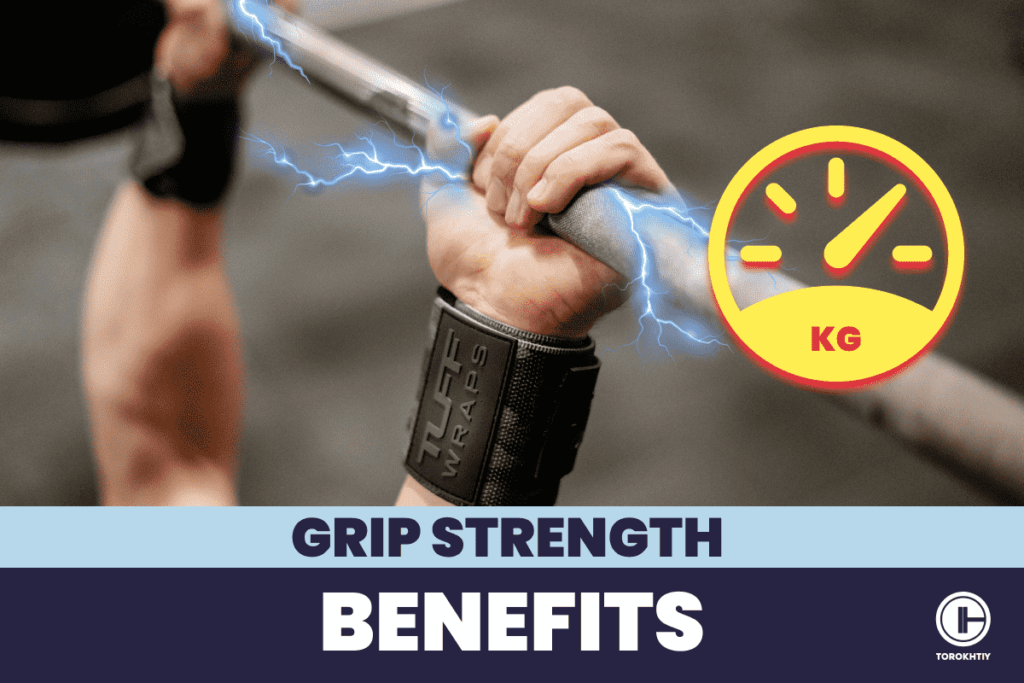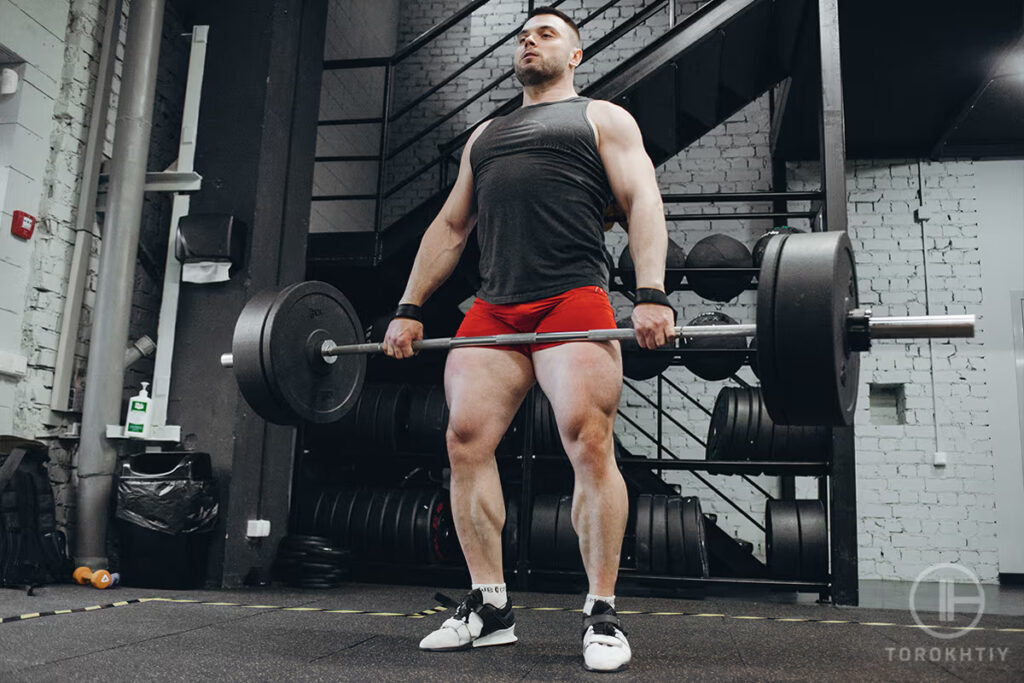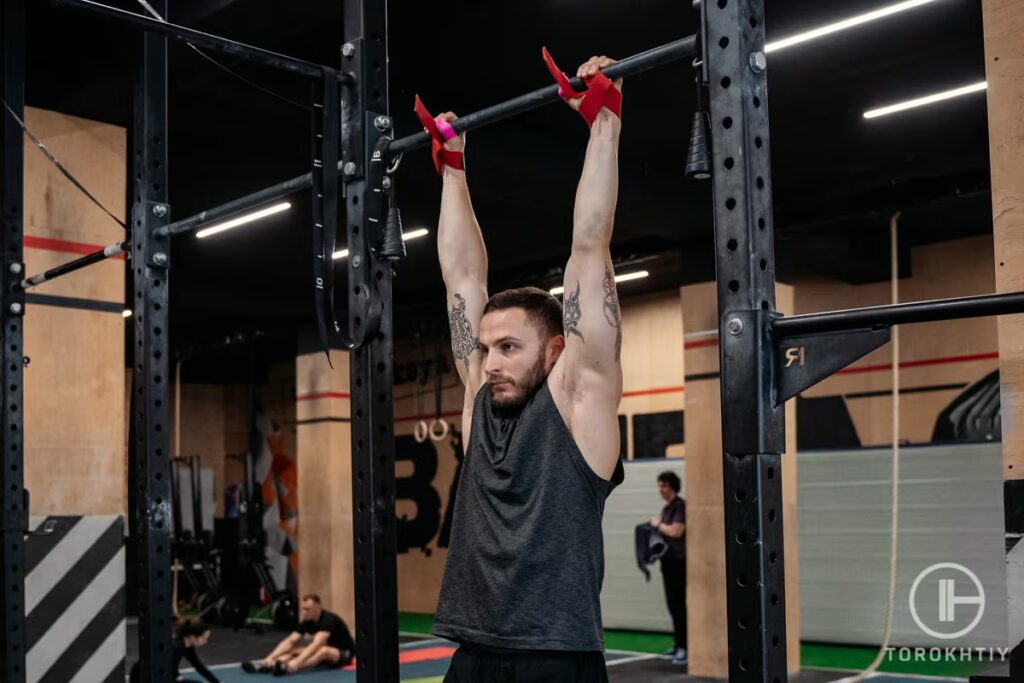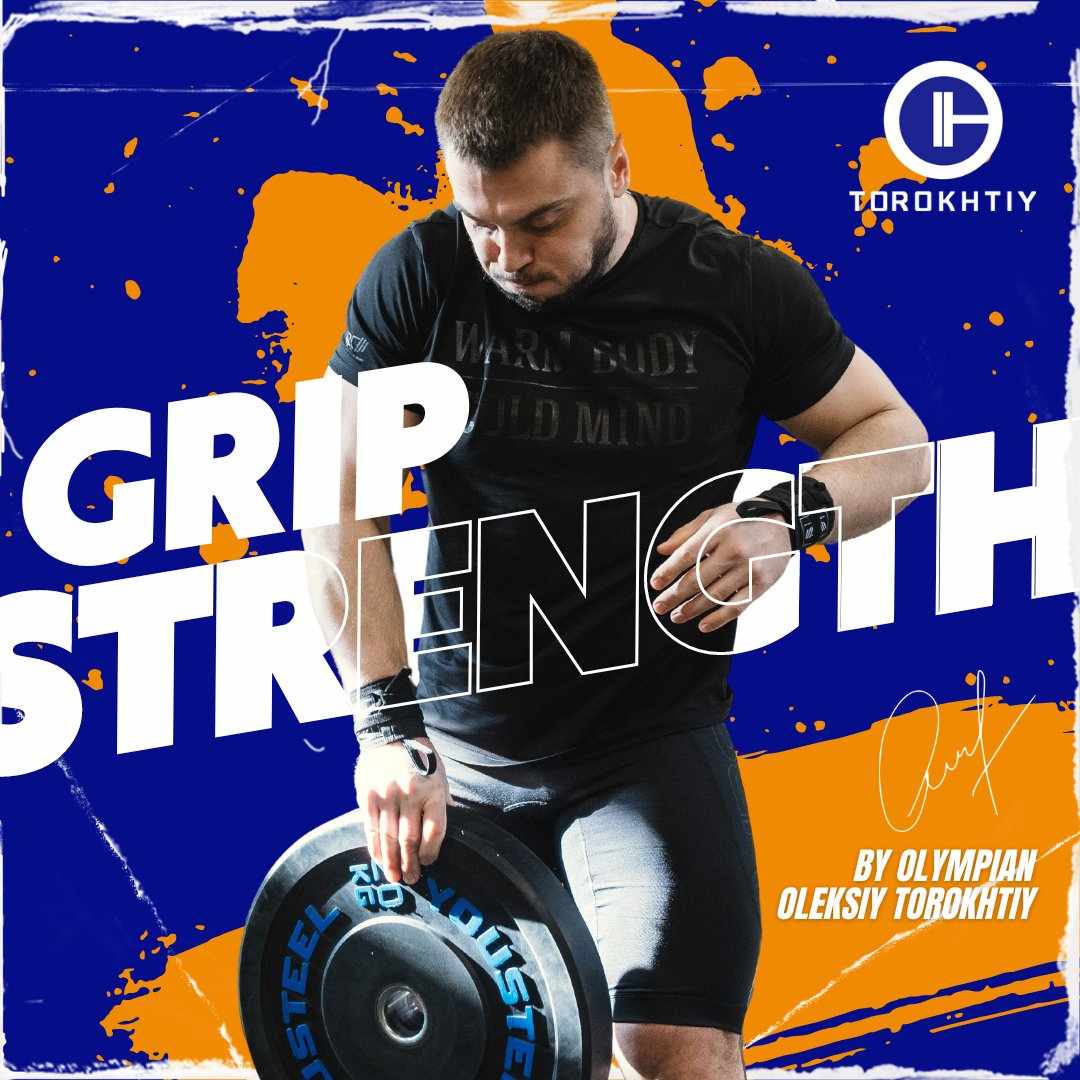5 Essential Grip Strength Benefits for Health & Performance
Author:
Reviewed by:
(21 years of Oly Lifting experience)
Unlock your full potential by engaging with our experts and community! Have questions about your fitness journey or looking for expert advice on weightlifting techniques? Don’t hesitate — leave a comment below and Sergii Putsov will provide a personalized answer and insights to help you reach your goals.
Torokhtiy is reader-supported. Some links are affiliate links, and we may earn a commission at no extra cost to you. See our disclosure page for details.
If you’re a fitness junkie or if you just like to work out, you probably focus on your big muscle groups most. These would be your back, quads, abs… You know how it is. But what about your grip strength? There are many grip strength benefits and a firm handshake isn’t just a social nicety, it can be an indicator of your overall health and fitness.
Think about how often you use your hands and forearms in your everyday life. Carrying groceries, typing on a keyboard, playing sports, even opening a super stubborn jar of pickles – a strong grip can make so much difference.
Believe it or not, there’s a whole science behind this, so you shouldn’t skip on your grip training in favor of some more popular exercises.
Let’s see what happens when you give your hand muscles some love (spoiler alert – good stuff only!) and why is grip strength important!
What are grip strength benefits? Strong grip is linked to better cardiovascular health, it can even indicate greater longevity, but aside from that, it can improve your performance in daily activities and sports, reduce the risk of injury, and improve hand dexterity.

3 Benefits of Having a Strong Grip
If you work out on a regular basis, you’re either after being healthier or having a good-looking body (possibly both). That’s commendable, but the problem with that approach is, you’re likely neglecting some smaller, seemingly more insignificant aspects, like your grip.
Having a strong grip is more important than you know because it correlates with your body strength in general, but let’s see exactly what does grip strength do for you and how it affects your life.
✅ Everyday Life and Tasks
When your grip is nice and firm, everyday life gets easier. Handling tools, carrying groceries, opening jars… Everything gets more efficient, even things like typing on a keyboard. Nobody wants to struggle with mundane tasks, but that’s exactly what happens when you don’t make sure to strengthen your grip.
As you age, the strength of your grip will decline, and that will make your everyday life even harder if you start off with having a weak grip.
✅ Athletic Performance
People who have a strong grip can handle equipment better, which means their movements are more precise and they experience less fatigue if they’re doing something for a long time, and this goes for all sports.
Whether you’re gripping a tennis racket, swinging a golf club, dribbling a basketball, whatever the case may be, a good grip will give you better control, power, and endurance. If you want to improve your performance, start with making your grip stronger.

✅ Injury Prevention
It’s not all about performance, of course, preventing injuries is important, too. A strong grip contributes to overall musculoskeletal stability, so there’s less chance of wrist strains, tendonitis, and fractures.
If you take the time to strengthen your grip, you’ll get more support and control over your movements, meaning you’re at less risk of accidents and overexertion. It’s not a miracle-worker, but you’ll save yourself from a decent amount of pain and discomfort with a strong grip.
Relationship Between Grip Strength, Longevity, and Mortality Risk
There’s new research that shows a fascinating relationship between grip strength and longevity. Stronger grips have been linked to lower mortality rates, better overall health, and better cardiovascular health, making it a potential way of predicting your overall well-being. People who have a strong grip are generally well-trained and physically active on a regular basis, so they’re at lower risk for certain diseases and are usually healthier.
A weak grip might be a sign of cardiovascular disease and people with weaker grips may face higher mortality risks and be more prone to health issues that are related to age.
Follow us!

Free!
Get a 2-week Weightlifting Program as a bonus for the subscription to kickstart your training plan!

Free!
Psychological Benefits
Although it mostly impacts your physical health, strong grip benefits are psychological, as well, and it’s associated with better cognitive function. If you really think about it, it makes perfect sense. You get a lot of confidence from knowing you’re physically competent to deal with whatever life throws at you, be it an annoying pickle jar, carrying a heavy bag, or handling heavy equipment.
There’s also something to be said about discipline and a positive mindset; when you train to make your grip stronger, and you’re consistent, you practice discipline and perseverance, not to mention how satisfying it is to see actual results.
| Benefit | Description |
|---|---|
| Everyday Life and Tasks | A strong grip makes daily tasks (like handling tools, carrying groceries, opening jars, etc.) easier and more effective. |
| Athletic Performance | A strong grip makes it easier to handle equipment, which makes your movements more precise, reduces fatigue, and improves endurance. |
| Injury Prevention | The stronger the grip, the greater your musculoskeletal stability. It reduces the risk of strains, tendonitis, and fractures, improves support and control to minimize the chances of accidents. |
| Relationship with Longevity | Research links grip strength with longevity and cardiovascular health. Strong grip is associated with lower mortality rates. |
| Psychological Benefits | Strong grip makes you more confident and improves resilience. The feeling of physical competence makes for a more positive mindset and consistent training cultivates discipline and perseverance. |
How to Measure Grip Strength?
It’s one thing to understand the importance of grip strength, but measuring it accurately is a whole different one. Luckily, there are a few ways you can do that, and all of them are reliable and you can count on the results to be correct. Let’s see how to do that.
1. Hand-Grip Dynamometer
A lot of people think of this as the gold standard for assessing grip strength, so you won’t go wrong with it. It’s a specialized device made to measure the force that is exerted by the hand muscles during a grip.
To use it, just squeeze it as hard as you can, and then you get precise readings of your grip strength in pounds or kilograms. This method is ideal for research studies and clinical evaluations because it gives objective, quantifiable results.
2. Pull-Up Bar Hanging
You’re probably thinking this will only test how strong your upper body is, but actually, this method will give a decent insight into how strong your grip is. All you do is hang from the bar for as long as you can while keeping a static position, which means you can’t allow your body to sway.

How long you’re able to hang will serve as an indirect measure of how strong your grip and hands are. This way of measuring grip strength is good for athletes and fitness junkies and gives a functional assessment.
3. Digital Grip Strength Testers
If you like the idea of a dynamometer but want something more portable and user-friendly, a digital strip tester will do the trick. It has an electronic sensor that will accurately measure the strength of your grip and then show you the results on its digital screen.
How to Improve Grip Strength?
Since you’ve seen the benefits of grip strength, it makes sense that you want to know how to make it stronger. There’s more than one way to do that, so you can pick and choose.
1. Exercises
Exercising is how you make your grip stronger. Cardio can be good, but strength training exercises should be your main focus.
Deadlifts are great because they engage a lot of muscle groups, and that includes your forearm and grip. It will contribute to your overall strength, including the grip.
Barbell and dumbbell rows are another good exercise because each of them relies on a strong grip to keep the weights under control throughout the movement, so it helps build strength in your hands and forearms.
You could also do farmers’ carry that will make your grip stronger and engage your core at the same time. But as far as exercises go, one of the most effective ones are pull-ups. Hanging from the bar will give your grip a real challenge, so if you include pull-ups into your routine, you’ll see a lot of improvement over time.
Tips From the Champ
Include exercises like wrist curls, reverse wrist curls, and plate pinches into your routine. They isolate and strengthen the muscles in your hands and forearms, which improves endurance and, over time, the strength of your grip.
Olympic Weightlifting Champion
2. Methods and Principles
If you have any experience with exercises at all, you know that you need to start light and up the intensity gradually, as your strength improves. This goes for all exercises, meaning you need to let your muscles and your grip develop over time.
As you get stronger, you can use heavier weights, do additional reps, or reduce rest periods. This is what will help keep plateaus at bay and your strength will keep developing.
You can track your progress to see how far you’ve come. This will allow you to adjust your training sessions if you need to, and it will also motivate you. Of course, you can’t forget to rest here and there because recovery is important. Otherwise, you risk injuries and your muscles won’t be able to adapt to the workouts you’re doing.
Avoiding Mistakes
Improving your grip strength will make your life better, but there’s not a chance you won’t make a mistake during training once in a while. They can put a damper on your progress and cause injuries so, even though you shouldn’t make yourself crazy by trying to be perfect, it’s good to be aware of them so you can avoid making them (up to a point).
❌ Incorrect Form
Form keeps you safe from getting injured, so if your form is off, you’re at higher risk of accidents and your training won’t be as effective. Make sure to put quality over quantity – focus on doing less reps with proper form instead of rushing through your workout and possibly having your form fail. If you’re a beginner, ask a professional trainer to help you out.
❌ Overtraining
Don’t push yourself too hard. It can be tempting to go the extra mile, especially if you’re really enthusiastic about developing your grip strength, but that’s usually not a good idea.
Overtraining can cause muscle imbalances, fatigue, and injuries, so in the end, you end up taking one step forward and two steps back. Include rest days into your routine and listen to your body during training.
If something is too much for you at the moment, set it aside and revisit it once you get stronger. Adequate volume is the key. Treat your grip muscles like any other muscle you train in the gym.
❌ Not Having Enough Variability
Static grip exercises are great if that’s not all you do. Grip is dynamic and real life needs you to move your joints, not just your hands and forearms. Vary your exercises and make them dynamic. If you don’t, you might end up having weaknesses in specific hand points or movements, which will mess with your functional strength in general.
Conclusion
Did you think your grip had such an impact on your health and everyday life? You probably didn’t, but now that you do, there’s no excuse not to work on it! You’ll improve your performance, you won’t get injured as easily, and your quality of life will improve.
There’s a ton of exercises you can do, but make sure to rest and give your muscles time to recover so they can develop properly, and never underestimate the importance of form.
What do you do to make your grip stronger? Do you have a favorite exercise? What issues have you come across during grip strength training and how did you handle them? What do you think, can grip strength make you stronger and have you noticed that it did that for you?
Leave your comments below and let’s help each other out!
Also read:
- Front Squat Grip Secrets – Techniques & Tips
- How To Improve Grip Strength For Pull-Ups: Ultimate Guide
- Master Grip and Wrist Strength with Kettlebell Wrist Workout
- Spotter’s Handbook: How to Spot a Squat?
- Strong Arms, No Pain: Tackling Elbow Discomfort from Weightlifting
- How To Get Bigger Wrists: Growth Strategies & Exercises
- Squat Foot Placement: Proper Foot Position Explained
References:
- Howard E. LeWine, MD “Grip strength may provide clues to heart health,” Harvard Health Publishing, https://www.health.harvard.edu/blog/grip-strength-may-provide-clues-to-heart-health-201505198022 (accessed April 3rd, 2024)
- Jedd Pratt, Giuseppe De Vito, Marco Narici, Ricardo Segurado, Jackie Dolan, Judith Conroy, Colin Boreham “Grip strength performance from 9431 participants of the GenoFit study: normative data and associated factors,” GeroScience Volume 43 (2021): 2533–2546.
- John Cronin, Trent Lawton, Nigel Harris, Andrew Kilding, Daniel T. McMaster “A Brief Review of Handgrip Strength and Sport Performance,” Journal of Strength and Conditioning Research 31, no. 11 (November 2017): 3187-3217.
- Richard W. Bohannon “Grip Strength: An Indispensable Biomarker For Older Adults,” Clinical Interventions in Aging 14 (2019): 1681–1691.
- Rongtao Jiang, Margaret L. Westwater, Stephanie Noble, Matthew Rosenblatt, Wei Dai, Shile Qi, Jing Sui, Vince D. Calhoun, Dustin Scheinost, “Associations between grip strength, brain structure, and mental health in > 40,000 participants from the UK Biobank,” BMC Medicine volume 20, Article number: 286 (2022).
- “What Your Grip Strength Means for Your Overall Health — and Exercises To Improve It,” Cleveland Clinic, https://health.clevelandclinic.org/grip-strength/ (accessed April 3rd, 2024)
- Photos made by Torokhtiy Media Team.
Why Trust Us?
With over 20 years in Olympic weightlifting, strength training, nutrition coaching, and general fitness our team does its best to provide the audience with ultimate support and meet the needs and requirements of advanced athletes and professional lifters, as well as people who strive to open new opportunities and develop their physical capabilities with us.
By trusting the recommendations of our certified experts in coaching, nutrition, and sports training programming, as well as scientific consultants, and physiotherapists, we provide you with thorough, well-considered, and scientifically proven content. All the information given in the articles concerning workout programming, separate exercises, and athletic performance, in general, is based on verified data.
The product testing process is described in more detail here.
Author: Sergii Putsov
Head of Sport Science, PhD
Best Results: Snatch – 165 kg,
C&J – 200 kg
Sergii Putsov, Ph.D., is a former professional weightlifter and National team member, achieving multiple medals in the 94 kg weight category at national competitions. With a Master’s degree in “Olympic & Professional Sport Training” and a Sport Science Ph.D. from the International Olympic Academy, Greece, Sergii now leads as the Head of Sport Science. He specializes in designing training programs, writing insightful blog articles, providing live commentary at international weightlifting events, and conducting educational seminars worldwide alongside Olympic weightlifting expert Oleksiy Torokhtiy.
Reviewed by: Oleksiy Torokhtiy
Olympic Weightlifting Champion, PhD in Sport Science
Best Results: Snatch – 200 kg,
C&J – 240 kg
Oleksiy Torokhtiy is a professional athlete boasting 20 years of experience in Olympic weightlifting. With multiple European and World titles under his belt, he has showcased his prowess in two Olympic Games (Beijing 2008 and London 2012). Upon concluding his illustrious career, Oleksiy dedicated himself to coaching. By 2022, he had conducted over 200 weightlifting seminars worldwide. He is the visionary behind an international sportswear and accessories brand known for its motto, “Warm Body Cold Mind.” Additionally, he is an esteemed author and the creator of a series of training programs and eBooks.






Still have questions after reading our article? Unlock your full potential by engaging with our experts and community! Don’t hesitate — leave a comment below and Sergii Putsov will provide a personalized answer and insights to help you reach your goals.